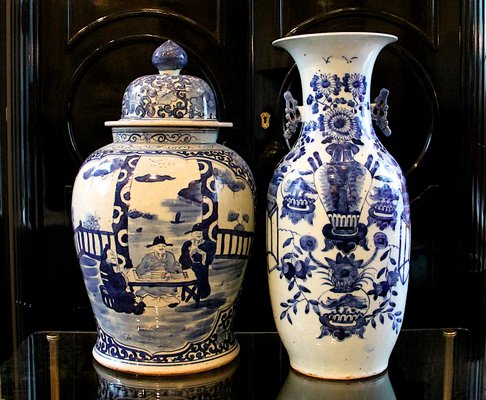

Nothing quite captures the imagination nor matches the popularity of blue and white ceramics, pottery and porcelains.
There is something about the color combination of blue and white that has almost universal appeal and has so for more than 1,000 years. What is it about blue and white that evokes the positive response and desire to have it that red and white or yellow and white or even black and white decoration on china doesn’t? What is it about the color blue?
Blue is a special color. It’s the color of the sky and the sea for starters. It’s also associated with depth and stability. Symbolically, it represents trust, loyalty (true blue!), wisdom, confidence and intelligence. It’s also associated with heaven, the Virgin Mary in Christianity, and truth. Studies show that the color blue has a calming effect on people. These are all symbolic and esoteric reasons for why the color blue is appealing but I would add that sometimes things can be popular and sought after simply because they are beautiful or even just pretty to look at.
Whether one is collecting blue and white ceramics or porcelains for its value as an investment or decorating for the summer with reproduction cache pots, vases and planters, the techniques in producing these objects remain the same. Blue and white covers a wide range of white pottery and porcelain that is decorated under the glaze with blue pigment, most notably cobalt oxide. The blue decoration is painted on by hand and was usually done by brush painting. Today, much is still hand done but stenciling techniques and transfer printing are also used. The origins of blue and white ware are found in Mesopotamia—some pieces have been found in present day Iraq that date to the ninth century. The artists then were trying to imitate lapis lazuli, a highly prized and expensive semi-precious stone. Cobalt found in what is today Oman on the Arabian Peninsula became the primary source for the blue used on pottery and ceramics in the Muslim world. Trading between Persia and China brought the cobalt pigments to the porcelain producing regions of the Chinese province Canton. Hence, “Canton ware”). Blue and white decoration became widely used in Chinese porcelain starting in the 14th century. Chinese pottery and porcelain was robustly traded globally; this is known as Chinese export ware. There was Chinese export for the Persian market as well as export for the European market brought to Europe by the Dutch and English.
So how, you might ask, did Europeans get the knowledge to start their own ceramic and porcelain trade? In an early example of “industrial spying,” the techniques were transmitted unwittingly via Francois Xavier d’Entrecolles, a Jesuit priest in China in the early 18th century. He was fascinated by the highly prized porcelain produced, and described the entire process in a letter to his superior in Paris in 1712. The letter was reproduced in France and manufacturing of blue and white began and several are still in existence like Sevres, founded in 1730, and Limoges, in 1771. The French, of course, were not alone in their pursuit of blue and white ceramic and porcelain wares of their own. A few years before the good father’s letter arrived in Paris, the Meissen Porcelain Manufactory had opened near Dresden, Germany, due to their discovery of the secret of hard-paste porcelain production. By the end of the 1700s, blue and white pottery and porcelain was being made throughout Europe: in England with jasperware, in Holland with Delftware and in Denmark with Royal Copenhagen.
The guide to assessing blue and white, whether pottery-based or porcelain, is essentially the same, whether it is of European or Asian origin. In the case of European china, the manufacturers early on marked their works. Meissen was the first to use “crossed swords” as its official mark. Marks and stamps on the underside can easily be looked up on the internet and will tell you the year and location of its manufacture. Chinese and Japanese things are a little more complicated since they didn’t always use stamps or markings and it is probably best to seek out an expert before purchasing an expensive piece, since the Chinese in particular do very convincing reproductions.
The quality of early blue and white is also found in the glazes used. Most Middle Eastern and Chinese ceramic artisans employed a tin glaze, which is similar in look to Delftware. Many other types of glaze were developed and used including salt glaze, ash glaze and feldspar glaze. The objective of all glazes is to create a finish—sometimes matte, other times glossy—rendering the object waterproof and making it suitable for holding liquids. As an added benefit, a glaze often enhances the underlying design or texture.
In either case, one should approach ceramics with a few things in mind. How does it feel in your hand? Is it heavy (probably ceramic or earthenware) or relatively light and delicate (probably porcelain)? Does it appear rare or different? Does it show quality and beautiful painting techniques? Is it in good condition (any cracks, chips, etc.)? Is the glaze stained or discolored? Does it seem to have historical value (commemorations)? And, of course, what does the seller have to say about the provenance of the piece? At the end of the day, any object needs to appeal to one’s overall sense of the piece itself. If it doesn’t pass that test, then might as well leave it in the display case.
For those not collecting for investment purposes but who love the look of blue and white pottery and china, there are innumerable types, styles and forms to choose from and many retailers in the Hamptons to buy it from. One is Jack Deamer of JED Design and Antiques in Sag Harbor, who features a combination of old and current production Chinese export ware. He even has a blue and white ceramic table; it’s a single-center pedestal with a 36-inch diameter hand-painted top! And there are others who have substantial collections of blue and white ceramics and porcelains: English Country Antiques in Bridgehampton has a stunning array and Sage Street Antiques in Sag Harbor has a lot of unique items, as does Mecox Gardens in Southampton. For those on a budget or looking for strictly decorative blue and white ceramics, we have William Sonoma, Pier 1, Pottery Barn and virtually every garden center on the East End.
When I asked Mr. Deamer recently what it was about blue and white that made it so appealing, he said maybe because it’s simple, it’s elegant, it’s beautiful and it’s accessible. It is all that, and whether European or Asian the love of blue and white continues today as it has for more than a thousand years.
 More Posts from Jack Crimmins
More Posts from Jack Crimmins